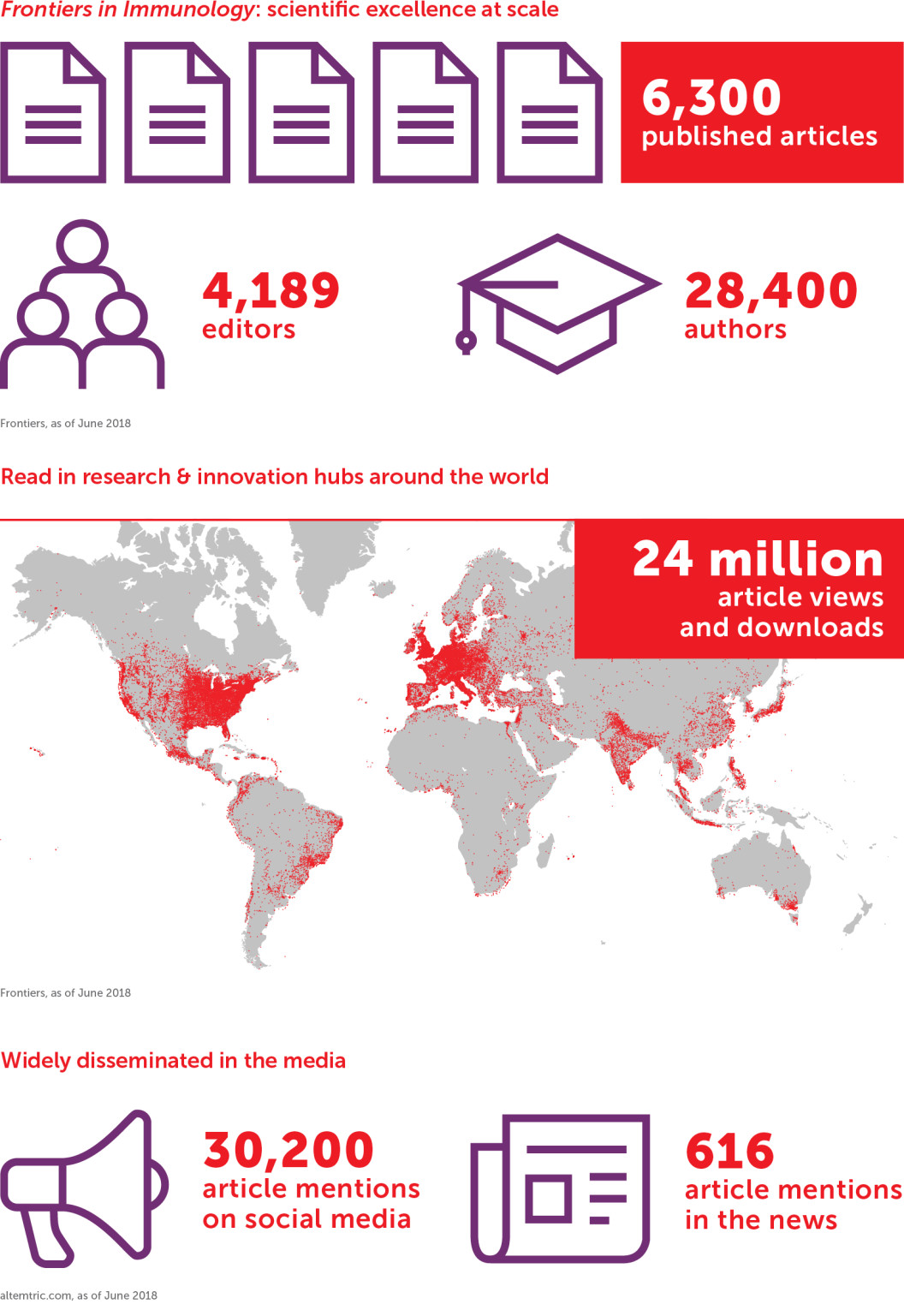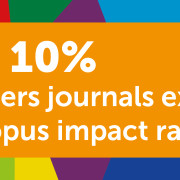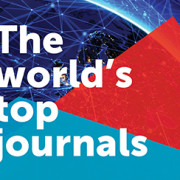- Science News
- Impact analysis
- Journal impact: Frontiers in Immunology
Journal impact: Frontiers in Immunology
Frontiers in Immunology is among the top 10 most-cited journals in its field and ranks in the top Impact Factor and CiteScore percentiles

Frontiers in Immunology continues to rank among the world’s top immunology journals in terms of influence and quality, as shown by our analysis of the 2017 Journal Citation Reports (JCR-2017; 2018, Clarivate Analytics), 2017 CiteScore edition (2018, Scopus, Elsevier) and other impact metrics.
The world’s 6th most-cited journal — and most-cited open-access journal — in the JCR category of Immunology, with 6,547 citations in 2017 to 1,811 articles published in 2015 and 2016 (Figure 1)
The world’s 3rd most-cited journal — and most-cited open-access journal — in the CiteScore category of Immunology & Allergy, with 11,153 citations in 2017 to 1,984 articles published in 2014, 2015 and 2016 (Figure 1)
The world’s 7th most-cited journal — and 2nd most-cited open-access journal — in the CiteScore category of Immunology (Figure 1)
Ranks in the 81st percentile of journal Impact Factors in the JCR Immunology category, with an Impact Factor of 5.511 (Figure 2)
Ranks in the 87th CiteScore percentile in the Immunology category and 89th CiteScore percentile in the Immunology & Allergy category, with a CiteScore of 5.62 (Figure 2)
6,300 published articles to date
58,000 citations to date
24 million article views and downloads to date
Articles mentioned 600 times in the news to date
Articles mentioned 30,200 times on social media to date

Figure 1: Analysis of the top 10 most-cited journals and top 10 most cited open-access journals in the JCR Immunology category (JCR-2017, released in 2018 by Clarivate Analytics) and CiteScore Immunology and Immunology & Allergy categories (2017 edition, released in 2018 by Scopus, Elsevier). Bar plots show the total number of citations in 2017 to articles published in 2015 and 2016 (JCR) and 2014, 2015 and 2016 (CiteScore), with Frontiers in Immunology in red. A total of 155 journals are listed in the Immunology category in the 2017 JCR edition, of which 22 are Open Access. A total of 166 and 190 journals are listed in the Immunology & Allergy and Immunology categories in the 2017 CiteScore edition, respectively, of which 27 and 35 are Open Access, respectively.

Figure 2: Analysis of Impact Factor and CiteScore rankings in the JCR Immunology category and CiteScore Immunology and Immunology & Allergy categories. Grey lines represent all journals in each category ranked by their 2017 Impact Factor and CiteScore percentiles, with Frontiers in Immunology shown as a red dot. Impact Factor is the average number of citations received in 2017 to articles published in 2015 and 2016, while CiteScore represents average citations in 2017 to articles published in 2014, 2015 and 2016. A total of 155 journals are listed in the Immunology category in the 2017 JCR edition, of which 22 are Open Access. A total of 166 and 190 journals are listed in the Immunology & Allergy and Immunology categories in the 2017 CiteScore edition, respectively, of which 27 and 35 are Open Access, respectively; however the analysis here includes only those journals with a full three-year publication history, that is, with published articles in 2015, 2016 and 2017.

Top research in 2017
Hottest Research Topics
Advanced immunization technologies for next generation vaccines
Tailoring NK cell receptor-ligand interactions: an art in evolution
Differentiation and mechanisms of activation of innate lymphoid cells
Top article picks
Leaky gut as a danger signal for autoimmune diseases
Vitamin D in autoimmunity: molecular mechanisms and therapeutic potential
Hello from the other side: how autoantibodies circumvent the blood–brain barrier in autoimmune encephalitis
Aged gut microbiota contributes to systemical inflammaging after transfer to germ-free mice
Immunological and clinical effect of diet modulation of the gut microbiome in multiple sclerosis patients: a pilot study
Macrophage metabolism as therapeutic target for cancer, atherosclerosis, and obesity
Major histocompatibility complex (MHC) Class I and MHC Class II Proteins: conformational plasticity in antigen presentation
Unperturbed cytotoxic lymphocyte phenotype and function in myalgic encephalomyelitis/chronic fatigue syndrome patients
Metabolic hallmarks of tumor and immune cells in the tumor microenvironment
Lysosome-dependent activation of human dendritic cells by the vaccine adjuvant QS-21
Scientific excellence at scale
The impressive performance of Frontiers in Immunology — and all Frontiers journals listed in the JCR and CiteScore metrics — reflects the continued success and influence of the Frontiers Open Science model of scientific excellence at scale.
All of this is only possible thanks to our research community and stellar editorial board. Frontiers congratulates Field Chief Editor Luigi Daniele Notarangelo and all Specialty Chief Editors, as well as the diligent work of the Associate and Review Editors, authors and the Frontiers Journal Management team, for this outstanding achievement.







